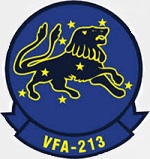Hobby Master HA5119 US Navy Boeing F/A-18F Block III Advanced Super Hornet Strike Fighter - 166674, VFA-213 "Blacklions", USS George H. W. Bush {CVN-77), Operation Inherent Resolve, 2017 [Low-Vis Scheme] (1:72 Scale)
"Bigger, Higher, Faster, Farther."
- Thinking within the US Air Force during the late 1970s
 The Boeing F/A-18E and F/A-18F Super Hornet are twin-engine carrier-capable multirole fighter aircraft variants based on the McDonnell Douglas F/A-18 Hornet. The F/A-18E single-seat and F/A-18F tandem-seat variants are larger and more advanced derivatives of the F/A-18C and D Hornet. The Super Hornet has an internal 20 mm M61 rotary cannon and can carry air-to-air missiles and air-to-surface weapons. Additional fuel can be carried in up to five external fuel tanks and the aircraft can be configured as an airborne tanker by adding an external air refueling system.
The Boeing F/A-18E and F/A-18F Super Hornet are twin-engine carrier-capable multirole fighter aircraft variants based on the McDonnell Douglas F/A-18 Hornet. The F/A-18E single-seat and F/A-18F tandem-seat variants are larger and more advanced derivatives of the F/A-18C and D Hornet. The Super Hornet has an internal 20 mm M61 rotary cannon and can carry air-to-air missiles and air-to-surface weapons. Additional fuel can be carried in up to five external fuel tanks and the aircraft can be configured as an airborne tanker by adding an external air refueling system.
Designed and initially produced by McDonnell Douglas, the Super Hornet first flew in 1995. Full-rate production began in September 1997, after the merger of McDonnell Douglas and Boeing the previous month. The Super Hornet entered service with the United States Navy in 1999, replacing the Grumman F-14 Tomcat, which was retired in 2006; the Super Hornet serves alongside the original Hornet. The Royal Australian Air Force (RAAF), which has operated the F/A-18A as its main fighter since 1984, ordered the F/A-18F in 2007 to replace its aging F-111C fleet. RAAF Super Hornets entered service in December 2010.
Pictured here is a gorgeous 1:72 scale diecast replica of a US Navy F/A-18F Block III Advanced Super Hornet Strike Fighter that was attached to VFA-213 "Blacklions", then embarked upon the USS George H. W. Bush {CVN-77), during Operation Inherent Resolve, in 2017.
Sold Out!
Dimensions:
Wingspan: 7-1/2-inches
Length: 9-inches
Release Date: September 2021
 Historical Account: "Blacklions" - Strike Fighter Squadron 213 (VFA-213) Blacklions is an aviation unit of the United States Navy based at Naval Air Station Oceana, Virginia (USA). It was established in 1955 and is currently equipped with the Boeing F/A-18F Super Hornet. The squadron is assigned to Carrier Air Wing Eight and uses the radio call sign Lion.
Historical Account: "Blacklions" - Strike Fighter Squadron 213 (VFA-213) Blacklions is an aviation unit of the United States Navy based at Naval Air Station Oceana, Virginia (USA). It was established in 1955 and is currently equipped with the Boeing F/A-18F Super Hornet. The squadron is assigned to Carrier Air Wing Eight and uses the radio call sign Lion.
After the September 11th, 2001, attacks, USS Carl Vinson with CVW-11 was the first carrier battle group on station in the North Arabian Sea, preparing for attacks against Afghanistan. On October 7th, 2001, during a CVW-11 strike, VF-213 dropped the first bombs of Operation Enduring Freedom on an SA-3 site near Kabul International Airport. VF-213 was instrumental in their reconnaissance role, utilizing their TARPS pods, and also provided laser weapon guidance for F/A-18 Hornets and GPS weapons coordinates for Hornets and USAF strike aircraft. During the ten weeks VF-213 were supporting OEF they flew over 500 combat sorties, over 2,600 combat flight hours and expended 435,000 pounds of ordnance and provided valuable reconnaissance with the TARPS pods. VF-213 was also the first F-14 unit to use its internal 20 mm cannon in combat during the Battle of Mazar e Sharif VF-213 received the 2001 Commander Naval Air Pacific Fleet Battle "E", Chief of Naval Operations (CNO) Safety "S", Clifton Award and the Commander Fighter Wing Atlantic Golden Wrench for their performance in 2001.
After the 2001-cruise ended in 2002, VF-213 changed air wings from CVW-11 to CVW-8. On March 22nd, 2003, VF-213 deployed aboard USS Theodore Roosevelt to the Mediterranean Sea in support of Operation Iraqi Freedom. During the war VF-213 would fly 198 strike, combat air patrol and ground forces support missions, delivering 102 laser-guided bombs and 94 JDAM bombs.
VF-213 was paired up with VF-31 Tomcatters for the 2005-2006 final F-14 Tomcat cruise on board USS Theodore Roosevelt. During the cruise, VF-213 and VF-31 received ROVER upgrades to their aircraft, enabling them to transmit real-time images from their LANTIRN sensor to ground operators. VF-31 and 213 collectively completed 1,163 combat sorties, and dropped 9,500 pounds of ordnance during reconnaissance, surveillance, and close air support missions in support of OIF.
On March 10th, 2006, VF-213 returned to NAS Oceana after the final F-14 cruise. All 22 Tomcats flew together in a wedge formation over NAS Oceana as hundreds of people cheered.


